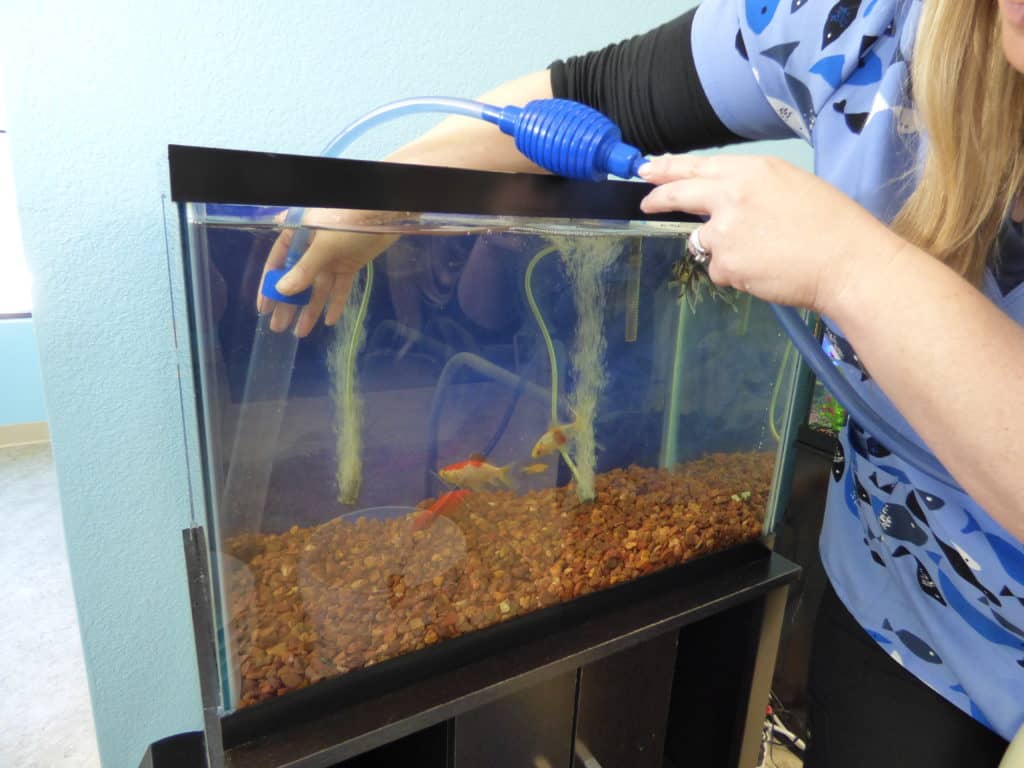Fish tank substrate refers to the gravel, rocks, sand, etc that is on the bottom of your tank. Certainly it increases your tank’s aesthetic appeal, but do you really need it? The answer = no.
“But my fish tank substrate provides biological filtration!”
Yes, your substrate does hold some of the friendly nitrogen-converting bacteria, but to a significantly lower level than your filter. Since your filter is constantly receiving new water flow, those bacteria are constantly being fed their ammonia and nitrite requirements. Water flow in your substrate is severely decreased compared to your filter and therefore not a big component of your biological filtration. Without a substrate, your nitrogen cycle will not suffer. (Don’t have a filter? Then you have bigger problems.)
“My undergravel filter won’t work without substrate!”
Actually, an undergravel filter works better without substrate. For those of you unfamiliar with the concept, and undergravel filter lays across the bottom of your tank and pulls waste from the bottom of your tank directly to your filter. It’s a great concept, if you keep it clean. Unfortunately, most substrates will plug up the intake of your undergravel filter our only pull water from the sides of your tank where the current is greater, making them less effective.
“My fish use the substrate to scratch themselves!”
Ouch. Yes, we’re using actual quotes here. Usually, this type of scratching is known as “flashing.” It is a common behavior of fish suffering from a parasite infestation. Parasites on fish = bad. Get your fish diagnosed and treated and you won’t have to worry about them “scratching” themselves.
“What’s the best fish tank substrate?”
The “best” substrate has a different answer depending on your type of tank. For most aquarium fish, typical gravel substrate is sufficient. It comes in lots of colors to suit your tankscape and is made specifically for fish tanks. If you have bottom feeders, such as catfish and loaches, they may benefit from a sandy substrate that isn’t so heavy to move. If you have a negatively buoyant goldfish, a smooth substrate, such as a bare bottom or glass stones will help protect the skin on their bodies in contact with the bottom of your tank. How your fish interacts with the bottom of their water column will determine what kind of substrate is best for them. Do your research!

If you are using “found” substrate, as in you took it from somewhere in the wild, NEVER use substrate that has been in contact with any other fish. You can try to bleach/bake, it but it will never be 100% safe. Soak any rocks/wood in tap water overnight. If you notice any odd patches of oil on the surface after the soak, toss it. You can add 10% bleach if it is non-porous. Learn more about how to safely disinfect fish equipment.
“So a bare bottom tank is okay?”
Sure. Your fish probably appreciate a substrate and it will provide a footing for any decor. However, it is significantly easier to clean your tank. If you are going to have a bare bottom tank, be sure to provide decor your fish can interact with. It is rare that a fish will thrive in a completely empty tank. It is common to have bare bottoms in quarantine tanks in order to make them easier to clean. Quarantine fish are usually not feeling great from either being in a new environment or disease, so make sure to give them places to take cover.
And guess what? A bare bottom is also the best option for your fish pond!


Are large blue guarmes a good fish to have with snails in a aquarium
Blue Gourami’s are not commonly snail eaters, but may resort to eating them if they are not fed enough.
In the video associated with this post you seem to not be in favor of sand for non-marine tanks. My question is: would sand be a better choice than gravel for goldfish given their love of sifting around the substrate?
I’ve seen mixed messages on the internet that sand may be better than gravel because it is less likely to get stuck in their mouths or impacted in their GI tract. On the other hand, I’ve also seen people talk about impaction happening with sand as well. While I like the idea of it aesthetically, I’m more concerned about having a substrate so my goldfish can go rooting around in it as an enrichment activity.
In our 8 years in practice, we have not seen any goldfish with an impacted GI tract. I have never seen one of my colleagues present on such a case. One fish had a gravel pellet get stuck in his proximal oral cavity due to a congenital deformity. Either substrate is a fine choice for your fish. We have seen more problems with filtration getting clogged by sand rather than gravel, but that is it.
Pingback: Why Does My Fish Tank Smell? 7 Common Reasons Explained | Hepper
Pingback: Are Those Fish Tank Marbles Glass? – CelestialPets
Pingback: Splendid Saltwater Fish: Your Ultimate Guide to Reef-to-Aquarium Bliss!
Pingback: Aquarium Decor Masterclass: Enhancing the Aesthetic Appeal of Your Tank - King Aquarium